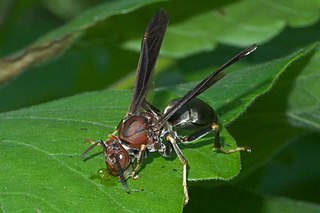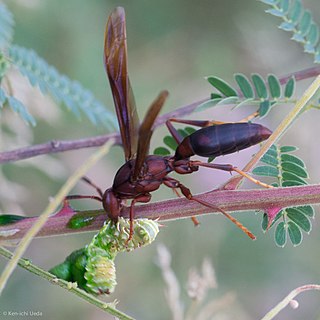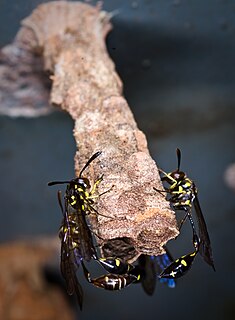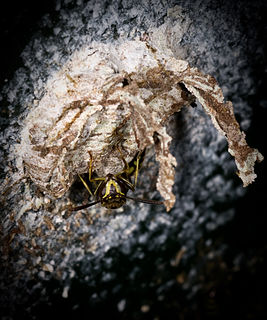
Paper wasps are vespid wasps that gather fibers from dead wood and plant stems, which they mix with saliva, and use to construct nests made of gray or brown papery material. Some types of paper wasps are also sometimes called umbrella wasps, due to the distinctive design of their nests.

The European paper wasp is one of the most common and well-known species of social wasps in the genus Polistes. Its diet is more diverse than that of most Polistes species—many genera of insects versus mainly caterpillars in other Polistes—giving it superior survival ability compared to other wasp species during a shortage of resources.

Polistes gallicus is a species of paper wasp found in various parts of Europe, excluding England, Denmark, and Scandinavia, from warmer climates to cooler regions north of the Alps. Nests of these social insects are created in these various conditions. The Polistes species use an oral secretion to construct their nests, which consist of a combination of saliva and chewed plant fibers. This structural mixture physically protects the nest from various harsh elements and from weathering over time.

The Stenogastrinae are a subfamily of social wasps included in the family Vespidae. They are sometimes called hover wasps owing to the particular hovering flight of some species. Their morphology and biology present interesting peculiarities.

Polistes metricus is a wasp native to North America. In the United States, it ranges throughout the southern Midwest, the South, and as far northeast as New York, but has recently been spotted in southwest Ontario. A single female specimen has also been reported from Dryden, Maine. Polistes metricus is dark colored, with yellow tarsi and black tibia. Nests of Polistes metricus can be found attached to the sides of buildings, trees, and shrubbery.

Polistes fuscatus, whose common name is the dark or northern paper wasp, is widely found in eastern North America, from southern Canada through the southern the United States. It often nests around human development. However, it greatly prefers areas in which wood is readily available for use as nest material, therefore they are also found near and in woodlands and savannas. P. fuscatus is a social wasp that is part of a complex society based around a single dominant foundress along with other cofoundresses and a dominance hierarchy.

Dufour's gland is an abdominal gland of certain insects, part of the anatomy of the ovipositor or sting apparatus in female members of Apocrita. The diversification of Hymenoptera took place in the Cretaceous and the gland may have developed at about this time as it is present in all three groups of Apocrita, the wasps, bees and ants.

Polistes canadensis, commonly known as the red paper wasp, is a Neotropical, primitively eusocial wasp. A largely predatory species, it hunts for caterpillar meat to supply its colony, often supplementing its developing larvae with nectar. The most widely distributed American species of the genus Polistes, it colonises multiple combs, which it rears year-round.

Liostenogaster flavolineata is an insect that belongs to the wasp family Vespidae. This hairy-faced hover wasp species is predominantly found in South Asian rain forests, especially in Malaysia. Individual colonies of this species are very small, but aggregations of nests allow for interactions between many smaller colonies. Some worker wasps, known as "helpers", will move between multiple nests in an attempt to improve their position in the dominance hierarchy. Its nests are pale-colored and are usually built with mud. Liostenogaster flavolineata is one of the most studied species in the Stenogastrinae.
Polistes atrimandibularis is one of three obligate social parasites among the Polistes wasps found in Europe. Of the three social paper wasp parasites, it is the smallest. It parasitizes multiple species such as P. dominula, P. nimpha, P. associus, P. gallicus, and P. biglumis. Females of P. atrimandibularis are unable to build a nest or produce workers, and therefore rely entirely on the host colony.

Parischnogaster mellyi is a medium-sized species of a hover wasp in the family Vespidae. It is found in Southeast Asia and is widely spread in Thailand and Malaysia. Its nests feature flexible and dynamic qualities, and they are commonly seen under roofs of houses and huts in rural areas. Hovering and patrolling behaviors are the species’ main defining behavioral features, and such activities are closely linked to its mating patterns.

Polistes biglumis is a species of social wasp within Polistes, the most common genus of paper wasp. It is distinguished mainly by its tendency to reside in montane climates in meadows or alpine areas. Selection pressure from the wasp's environment has led to several idiosyncrasies of its behavior and life cycle with respect to its relative species in the genus Polistes. It alone among paper wasps is often polyandrous. In addition, it has a truncated nesting season that gives rise to unique competitive dynamics among females of the species. P. biglumis wasps utilize an odor based recognition system that is the basis for all wasp to wasp interaction of the species. The wasp's life cycle is highly intertwined with that of Polistes atrimandibularis, an obligate social parasite wasp that frequently invades the combs of P. biglumis wasps.
Polistes sulcifer is a species of paper wasp in the genus Polistes that is found in Italy and Croatia. It is one of only three known Polistes obligate social parasites, sometimes referred to as "cuckoo paper wasps", and its host is the congeneric species Polistes dominula. As an obligate social parasite, this species has lost the ability to build nests, and relies on the host workers to raise its brood. P. sulcifer females use brute force, followed by chemical mimicry in order to successfully usurp a host nest and take over as the queen.

Ropalidia revolutionalis Ropalidia revolutionalis, the small brown paper wasp, is a diurnal social wasp of the family Vespidae. They are known for the distinctive combs they make for their nests, and they are mostly found in Queensland, Australia in the areas of Brisbane and Townsville. They are an independent founding wasp species, and they build new nests each spring. They can be helpful because they control insect pests in gardens. However, if threatened, they will sting humans and cause large amounts of pain.

The Black hover wasp, Parischnogaster alternata, is a eusocial wasp in the genus Parischnogaster. It is native to South-East Asia, and builds its nests in cavities located in dark and damp locations. The nests of Black hover wasps are often found in clusters, which serves as a passive defense mechanism against predators. The annual colony cycle begins with nest initiation by a single foundress though colonies typically consist of 2-3 associative females and helpers that aid in brood development, nest construction, and colony defense. Indicative of the name, female P. alternata are known to strategically hover near nests when visiting other colonies before landing. These intrusions produce responses ranging from aerial fighting to cooperative food sharing.
Parischnogaster nigricans serrei is a hover wasp species in the family Vespidae, and it is predominantly found in the Java region of Indonesia. Its nest cells are of conical structure, linearly attached to a string-like substratum. The nests are typically found in places open to human interactions, such as gardens, trees, or forests around villages. There is a clear dominance hierarchy within colonies, which often affects the behavioral activities of its members. The wasp’s most common predators are Vespa tropica, also known as the great banded hornet. P. nigricans serrei defends itself by flying away or giving out alarm calls.

Polistes versicolor, also known as the variegated paper wasp or yellow paper wasp, is a subtropical social wasp within Polistes, the most common genus of paper wasp. The most widely distributed South American wasp species, P. versicolor is particularly common in the Southeastern Brazilian states. This social wasp is commonly referred to as the yellow paper wasp due to the distinct yellow bands found on its thorax and abdomen. The P. versicolor nest, made of chewed vegetable fiber, is typically a single, uncovered comb attached to the substratum by a single petiole. The yellow wasp is frequently found in urban areas. New nests and colonies are usually founded by an association of females, sometimes in human buildings. The P. versicolor colony cycle broadly ranges from 3 to 10 months, although there appears to be no relationship between the colony's development and the season of the year. While yellow paper wasps do have clear annual colony cycles, many young queens have the opportunity to hibernate during the winter, forming optional winter aggregations. Dominance hierarchies within these aggregations are characterized by physical aggression of the dominant female(s) towards the associated females, who tend to be sisters. Wagging movements are also often used as a form of communication within the colony. The yellow paper wasp is generally predatory, capturing a wide range of insects, although it often feeds on pollen and nectar as well. Therefore, P. versicolor can be useful as a pollinator or as effective pest control.

Liostenogaster vechti is a type of eusocial hover wasp within the family Vespidae. They are typically brown and yellow in color and are considered a passive aggressive species. Their stings are less painful to humans than other social wasps, and they engage in associative nest foundation. They are mostly found on the Malaysian peninsula and are known for living in large clusters of small ring-shaped nests.

Polistes dorsalis is a species of social wasps that can be found throughout various parts of North America. It is classified under the Vespidae within the genus of Polistes. Male Polistes dorsalis wasps can be distinguished from other Polistes species by their distinctly prominent median tubercle of sternum 7. Both sexes can also be recognized due to their v- shaped yellow markings on their head. They are distributed widely across North America and can be found in sheltered nests, typically closer to the ground. These wasps live in a dominance hierarchy in which the queen's role differs from that of ordinary workers. When threatened, these wasps can deliver moderately painful stings. Their venom might also be of human interest for their antimicrobial uses.

Parischnogaster jacobsoni is a species of social wasp within Parischnogaster, the largest and least known genus of Stenogastrinae. It is distinguished mainly by its tendency to construct ant guards on its nests. Natural selection has led this wasp to have a thick substance emitted from its abdominal glands that allows it to protect its nest from invasions. Parischnogaster as a genus has been relatively unstudied; P. jacobsoni is one of the few investigated species because it has sufficient durability to live near human populations and it has demonstrated unusual resilience to pollution. While P. jacobsoni is a more complex organism than other wasps in Parischnogaster, the genus overall is relatively primitive with respect to social wasps as a whole.


















